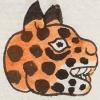tecuani (MH503r)
This black-line drawing of the element for what may be a ferocious wild animal ("literally a people-biter") shows the head of an animal in profile, looking toward the viewer's right. Its mouth is open, it is bearing its sharp teeth, and it has a large, protruding tongue. Its visible eye seems to be open.
Stephanie Wood
Jaguar is often the contemporary translation for tecuani, and most glyphs show animals that look like jaguars. Ocelotl is another name for jaguar, and glyphs of the ocelotl are very similar to glyphs for the tecuani. But there could be other wildcats that are called tecuani.
Stephanie Wood
1560
Jeff Haskett-Wood
wild cats, wildcats, ferocious wild animals, animales silvestres feroces, animales que comen personas
tecuani, ferocious wild animal, literally one that bites people, https://nahuatl.wired-humanities.org/content/tecuani
cua, to eat or to bite, https://nahuatl.wired-humanities.org/content/cua
una bestia feroz y salvaje
Stephanie Wood
Matrícula de Huexotzinco, folio 503r, World Digital Library, https://www.loc.gov/resource/gdcwdl.wdl_15282/?sp=83&st=image
This manuscript is hosted by the Library of Congress and the World Digital Library; used here with the Creative Commons, “Attribution-NonCommercial-ShareAlike 3.0 License” (CC-BY-NC-SAq 3.0).







